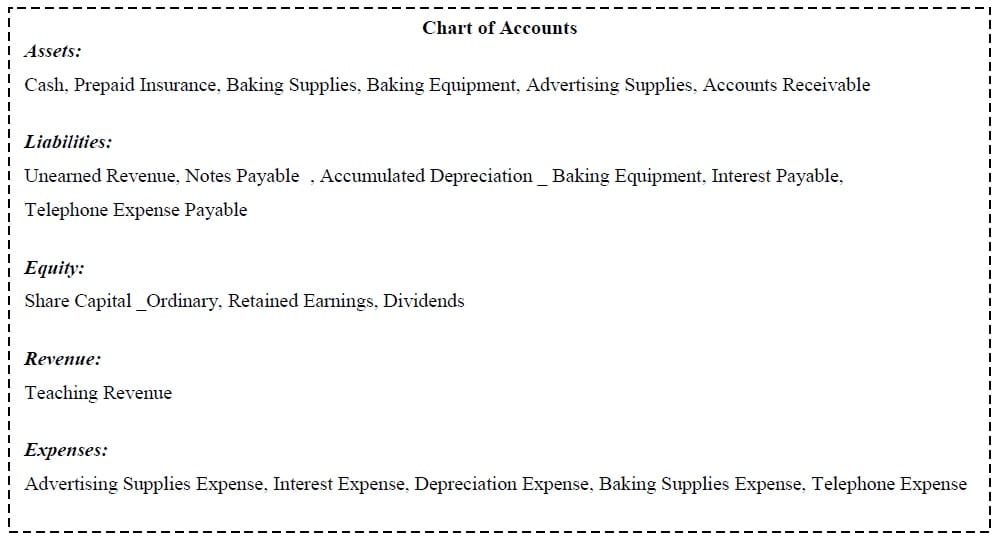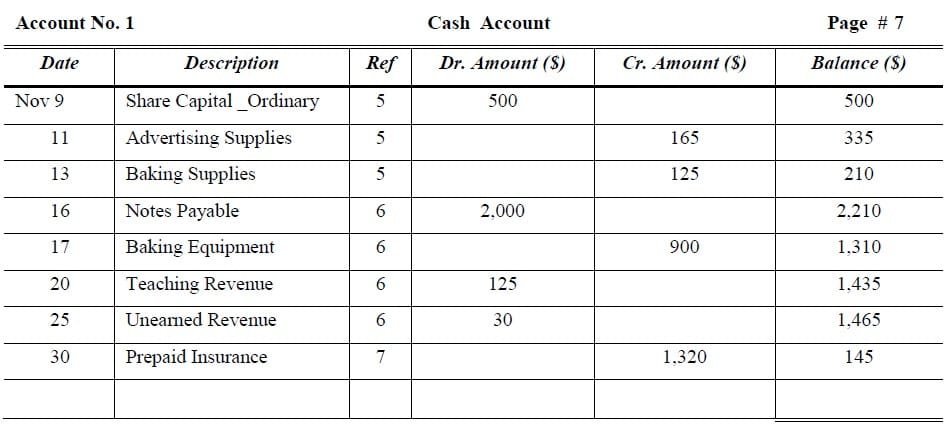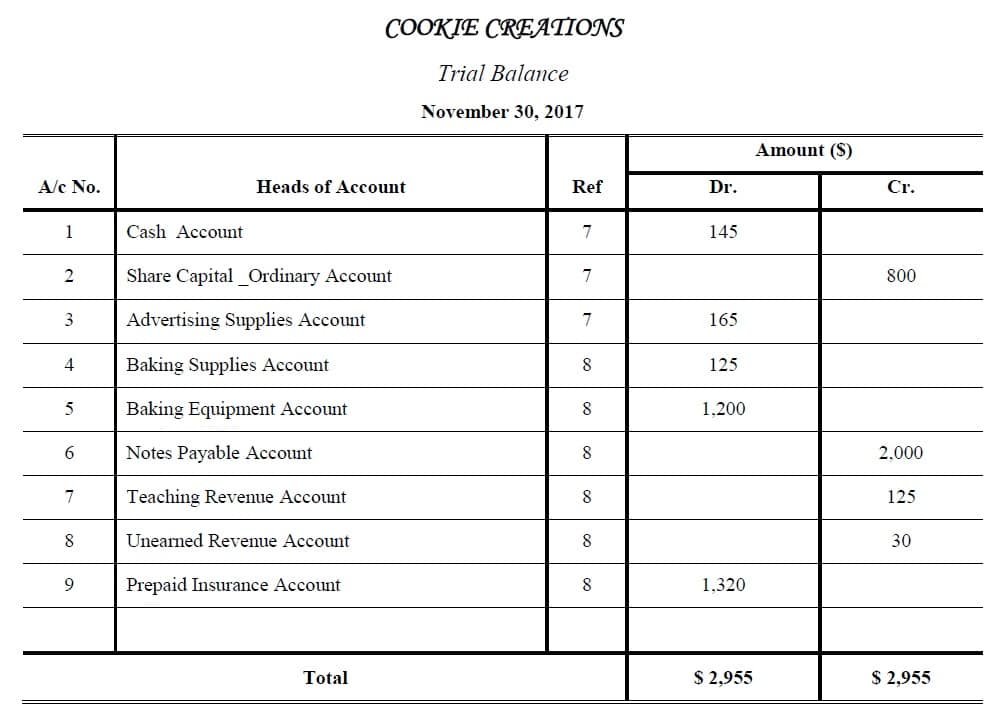Business Idea to Trial Balance Case Study
Previous Lesson: Financial Accounting
Next Lesson: Case Study 2: Trial Balance to Adjusted Trial Balance
Ms. Rabia spent much of her childhood learning the art of cookie-making from her grandmother. They passed many happy hours mastering every type of cookie imaginable and later creating new recipes that were both healthy and delicious.
Now at the start of her second year in college, Ms. Rabia is investigating various possibilities for starting her own business as part of the requirements of the entrepreneurship program in which she is enrolled. A long-time friend insists that Ms. Rabia has to somehow include cookies in her business plan. After a series of brainstorming sessions, she settles on the idea of operating a cookie-making school.
She will start on a part-time basis and offer her services in people’s homes. Now that she has started thinking about it, the possibilities seem endless. During the fall, she will concentrate on holiday cookies. She will offer individual lessons and group sessions (which will probably be more entertainment than education for the participants). Ms. Rabia also decides to include children in her target market.
The first difficult decision is coming up with the perfect name for her business. In the end, she settles on “Cookie Creations” and then moves on to more important issues.
Question 1:
What type of business i.e. sole Proprietorship, Partnership, or Joint Stock Company do you recommend that Ms. Rabia use for her business? Discuss the benefits and weaknesses of each form and give the reasons for your choice?
Solution:
Ms. Rabia has a choice between a sole proprietorship and a corporation. A partnership is not an option since she is the sole owner of the business. A proprietorship is the easiest to create and operate because there are no formal procedures involved in creating the proprietorship. However, if she operates the business as a proprietorship she will personally have unlimited liability for the debts of the business. Operating the business as a corporation would limit her liability to her investment in the business. Nancy will in all likelihood require the services of a lawyer to incorporate. Costs to incorporate as well as additional ongoing costs to administrate and operate the business as a corporation may be costly.
My recommendation is that Ms. Rabia chooses the corporate form of business organization. If she expands the business after graduation, she can raise additional capital by issuing more shares. In addition, she limits her liability to her investment in the business. If she decides to transfer ownership to another student, she can do so without dissolving the corporation.
Question 2:
Will Ms. Rabia needs accounting information? If yes, what information will she need and why? How often will she need this information?
Solution:
Yes, Ms. Rabia will need accounting information to help to operate her business. She will need information on her cash balance on a daily or weekly basis to help her determine if she can pay her bills. She will need to know the cost of her services so she can establish her prices. She will need to know revenue and expenses so she can report her net income for personal income tax purposes, on an annual basis. If she borrows money, she will need financial statements so lenders can assess the liquidity, solvency, and profitability of the business. Ms. Rabia would also find financial statements useful to better understand her business and identify any financial issues as early as possible. Monthly financial statements would be best because they are timelier, but they are also more work to prepare.
Question 3:
Identify specific asset, liability, and equity accounts that Cookie Creations will likely use to record its business transactions?
Solution:
Question 4:
Should Ms. Rabia open a separate bank account for the business? Why or why not?
Solution:
Ms. Rabia should have a separate bank account. This will make it easier to prepare financial statements for her business. The business is a separate entity from Ms. Rabia and must be accounted for separately.
Journal Entries for November, 2017
After researching the different forms of business organization, Ms. Rabia decides to operate “Cookie Creations”. She then starts the process of getting the business running. In November 2017, the following activities take place.
Nov 08. Ms. Rabia cashes her Savings Bonds and receives $520, which she deposits in her personal bank account.
Nov 09. She opens a bank account under the name “Cookie Creations” and transfers $500 from her personal account to the new account in exchange for ordinary shares.
Nov 11. Ms. Rabia pays $165 to have advertising brochures and posters printed. She plans to distribute these as opportunities arise.
Nov 13. She buys baking supplies, such as flour, sugar, butter, and chocolate chips, for $125 cash.
Nov 14. Ms. Rabia starts to gather some baking equipment to take with her when teaching the cookie classes. She has an excellent top-of-the-line food processor and mixer that originally cost her $750. Ms. Rabia decides to start using it only in her new business. She estimates that the equipment is currently worth $300. She invests the equipment in the business in exchange for ordinary shares.
Nov 16. Ms. Rabia realizes that her initial cash investment is not enough. Her grandmother lends her $2,000 cash, for which Ms. Rabia signs a note payable in the name of the business. Ms. Rabia deposits the money in the business bank account. (Hint: The note does not have to be repaid for 24 months. As a result, the notes payable should be reported in the accounts as the last liability and also on the statement of financial position as the last liability.)
Nov 17. She buys more baking equipment for $900 cash.
Nov 20. She teaches her first class and collects $125 cash.
Nov 25. Ms. Rabia books a second class for December 4 for $150. She receives $30 cash in advance as a down payment.
Nov 30. Ms. Rabia pays $1,320 for a one-year insurance policy that will expire on December 1, 2018.
Posting for November, 2017 (Running Balance Ledger)
Trial Balance November, 2017
References
Ramchandran, N., & Kakani, R. K. (2007). Financial Accounting for Management. (2nd, Ed.) New Delhi: Tata McGraw Hill.
Sehgal, A., & Sehgal, D. (n.d.). Advanced Accountancy (Vol. I & II). New Delhi: Taxmann Publication Pvt. Ltd.
Shukla, M. C., Grewal, T. S., & Gupta, S. C. (2008). Advanced Accountancy (Vol. I & II). New Delhi: S Chand & Co.
Weygandt, J. J., Kimmel, P. D., & Kieso, D. E. (2012). Accounting Principles (10th ed.). Hoboken: John Wiley & Sons, Inc.
Williams, M., & Bettner, H. (1999). Accounting (The basic for business decisions). (11th, Ed.) USA: Irwin McGraw- Hill.






















Hey folks,
This website is one of the best I have ever come across. Remember I studied accounting in the 1980s and this site has given a superb insight and made my life so easy. Thanks, folks, for the good job.
Christopher
Right here is the perfect website for everyone who wishes to understand this topic. Excellent stuff, just great!
Thankyou for helping out, superb info.